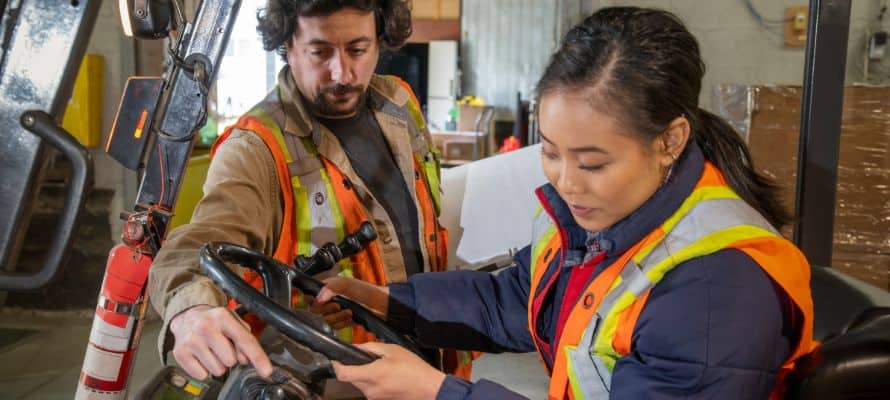Employee health and safety is critical. We have to protect our employees and train them on safe practices in the workplace. But just because we know it’s important to train and communicate about worker safety, doesn’t always mean it’s easy. In this blog, we’ll share advice on how to communicate your workplace safety tips in a way that engages your teams and ensures compliance.
What Are Workplace Safety Tips?
Workplace safety is a big umbrella term that encompasses all aspects of how you create safe working conditions for your employees. Within that, you’ll have safety policies and procedures that all your employees have to follow to avoid injury to themselves or others.
And nestled within that structure of rules are your workplace safety tips. These are the safety reminders that you share with your teams on an ongoing basis. Because industrial and healthcare environments have so many safety procedures, these tips are necessary to help keep safety best practices top of mind all year long.

Examples of Workplace Safety Tips
Before we can talk about examples of workplace safety tips, we have to talk about the many types of worker safety. In transportation and logistics, you’re going to have driver safety or warehouse safety. But healthcare is going to cover patient safety and personal protective equipment. Restaurants have to think about food safety. Computer-based workers might have to consider cybersecurity concerns.
So, workplace safety isn’t just one category. It’s not all just about protecting oneself from injury on the job—though that is a big category.
Let’s go through a few examples of workplace safety tips for a few categories.
Healthcare Examples
- Maintain your personal hygiene.
- Wear the appropriate PPE at all times.
Manufacturing Examples
- Wear the proper gear at all times.
- Don’t use cellphones on the manufacturing floor, and avoid distractions.
- Report safety concerns promptly to your supervisor.
Restaurant Examples
- Follow guidelines for hot and cold storage of food.
- Wash your hands regularly with soap and water to maintain hygiene.
- Follow steps to avoid cross contamination of foods to keep guests with food allergies safe.
Cybersecurity Examples
- Don’t click on links or download attachments from unknown senders.
- When you leave work for the day, don’t leave your laptop out.
- Don’t use your personal computer for work.
Why Communicating Workplace Safety is Critical
The importance of workplace safety communications are fairly obvious: it keeps your employees and customers safe.
But like any communication you send, you have to include the why. If your workers don’t understand why certain actions or protocols are important, they might not follow through or take it as seriously.
It’s just as important to regularly communicate about safety and shape your culture around safety as it is to just send out the messages regarding workplace safety.

5 Best Practices for Communicating Workplace Safety Tips
So, how do you create safety communication campaigns to share workplace safety tips regularly and in ways that engage our workers? Let’s review a few strategies.
- Include quick tips in your newsletter. Your newsletter is a great place to include regular safety reminders. It’s great when you can tie the tip of the week back to an ongoing initiative so it’s hyper-relevant. This is also a great way to keep safety policies top of mind.
- Translate your safety tips. No matter how you distribute safety tips, make sure that it’s accessible to your teams. This likely will require translation efforts, but it’s well worth the extra time and effort.
- Invest in video. Microlearning videos are a great way to break down complex and important topics into digestible segments. Not only do people learn best with audio and visual cues, but we also tend to be more willing to watch a short video than read a training manual.
- Manager safety training. At the end of the day, your managers are a critical part of maintaining a safety culture and ensuring protocols are followed. So, you have to invest in training your trainers. Teach your managers, not just what the safety policies are, but how to teach them to their employees too.
- Reward safe behaviors. Just like how you might create awards and recognition programs around your values, you can also do the same for employees who demonstrate safe behaviors consistently or who help keep their teams safe too. This shows your employees that safety really is something you prioritize and it sets the right example.
Safety Starts With Communication
We all agree safety is critical. But training your employees on workplace safety best practices has to start with the right communication framework. You need the right channels, the ability to target messages, and a way to measure those campaigns to ensure compliance.
But the majority of deskless employees—coincidentally also the employees who need safety training most—don’t have access to traditional intranets or a business email address.
How are you reaching those critical workers? Are you relying mostly on their manager to cascade safety messages down? On printed signage in the breakroom? On periodic training they complete online?
The truth is, if you don’t have a primary communication channel to reach your deskless teams directly, you open yourself up for risk. And you limit your ability to share workplace safety tips all year round.
Subscribe To The theEMPLOYEEapp Newsletter
Comments are closed.




